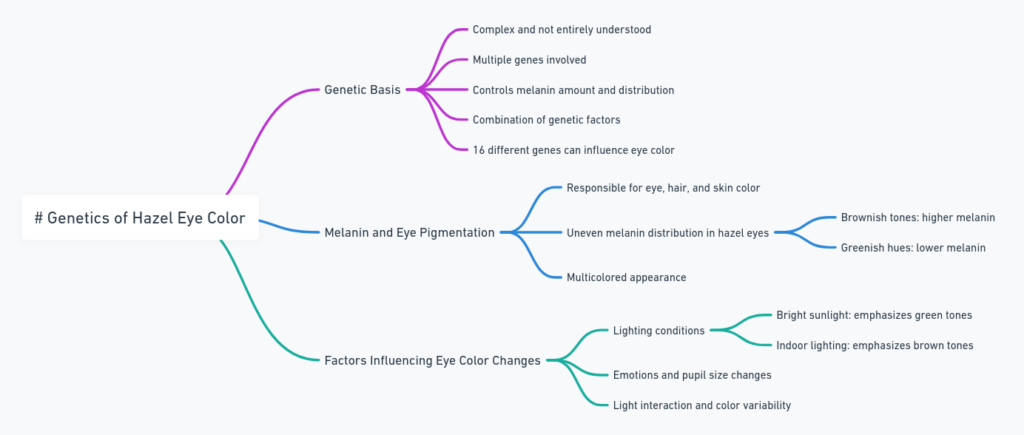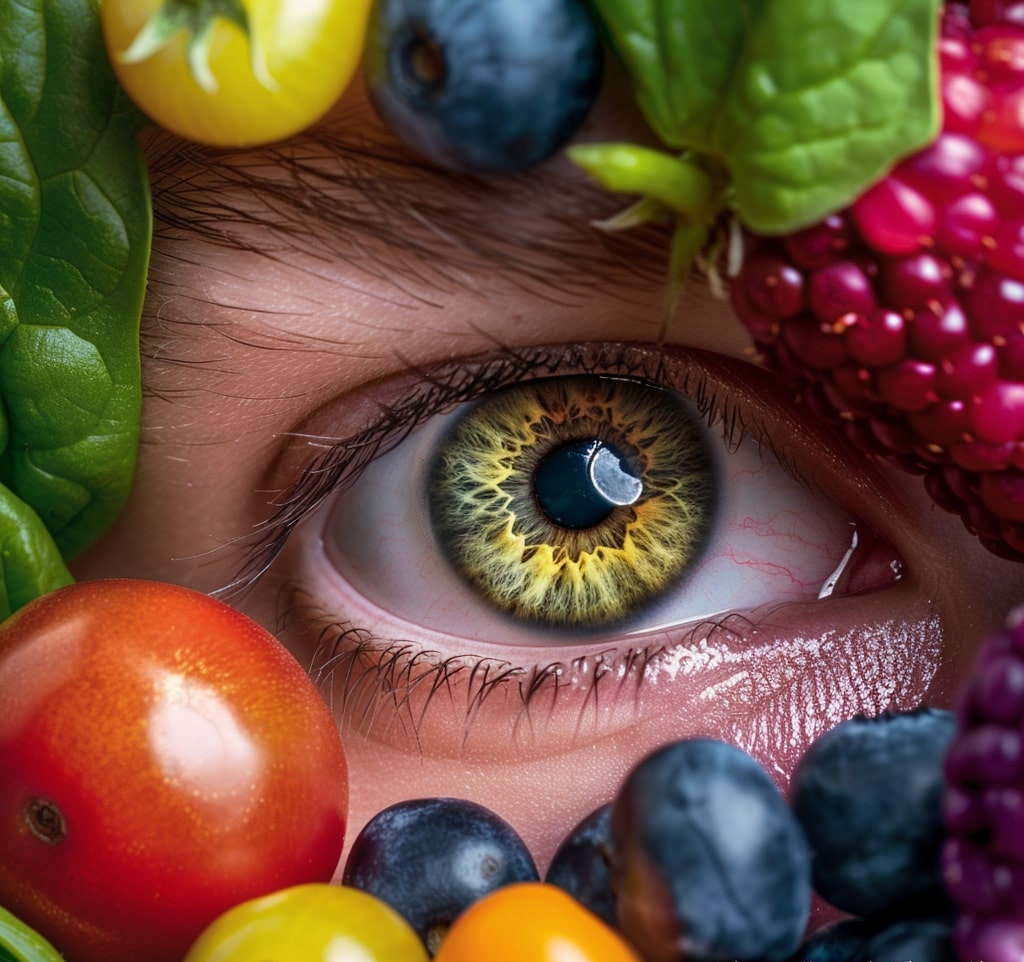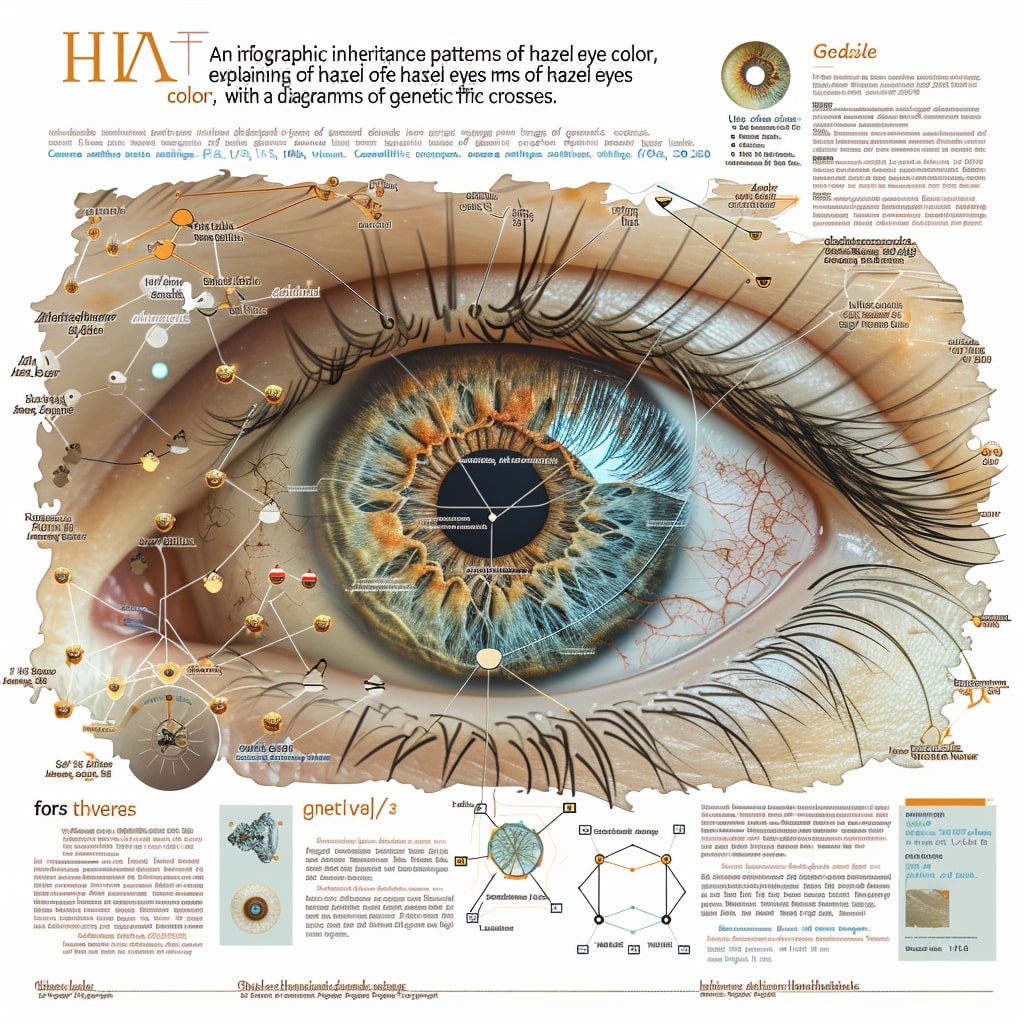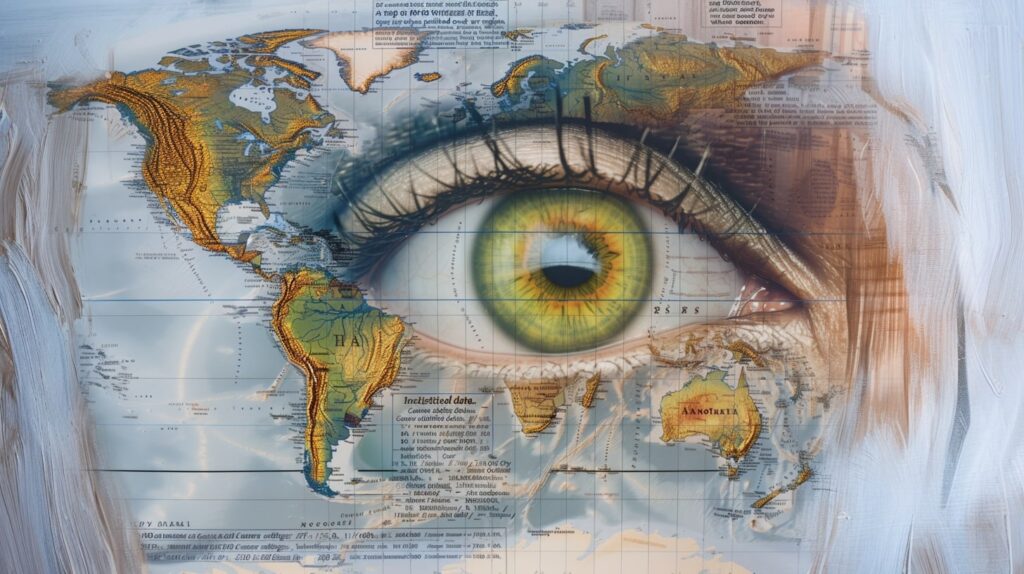Hazel Eyes
Ihr Leitfaden, Informationen und Tipps
Hazel Eyes: A Comprehensive Guide
Hazel eyes, with their captivating blend of green and brown hues, have long been a source of fascination and admiration. These unique eyes, often shimmering with hints of gold or even blue, tell a story as complex and intriguing as their appearance.
In this comprehensive guide, we will delve into the many facets of hazel eyes, exploring their scientific origins, the best ways to enhance their beauty, and essential tips for maintaining their health.
Whether you are lucky enough to possess hazel eyes yourself or are simply captivated by their charm, join us on this journey to uncover the secrets behind one of the rarest and most mesmerizing eye colors.
Key Takeaways of hazel eyes
| Topic | Key Points |
|---|
| What Are Hazel Eyes? | Hazel eyes are a unique blend of green, brown, and sometimes amber hues, creating a dynamic and changing appearance. They are relatively rare, occurring in about 5% of the global population. |
| The Science Behind Hazel Eyes | The genetics of hazel eye color involve multiple genes that control melanin distribution. Melanin levels and environmental factors influence the unique pigmentation and changing appearance of hazel eyes. |
| Enhancing Hazel Eyes with Eyewear | Rolf eyewear can enhance hazel eyes by complementing their colors. Frame colors like brown, green, and gold can make hazel eyes stand out. UV-protective sunglasses from Rolf are essential for eye health. |
| Enhancing Hazel Eyes with Makeup | Makeup in complementary colors such as purple, gold, and green can enhance hazel eyes. Step-by-step tutorials and celebrity looks provide inspiration for creating stunning eye makeup. |
| Enhancing Hazel Eyes with Clothing | Clothing in colors like green, brown, and gold can highlight hazel eyes. Coordinating outfits and accessories can further enhance their appearance. |
| Eye Health for Hazel Eyes | Regular eye care, including protection from UV damage and proper nutrition, is essential for maintaining the health of hazel eyes. Regular check-ups and protective measures can help keep hazel eyes healthy. |
| Cultural Significance and Myths | Hazel eyes have various cultural significances and myths associated with them. Historical beliefs, literary references, and common misconceptions contribute to their mystique. |
| Personality Traits Associated with Hazel Eyes | Psychological studies and popular perceptions link hazel eyes with certain personality traits. Real-life examples and stereotypes often highlight the unique and charismatic nature of individuals with hazel eyes. |
The Science Behind Hazel Eyes
Genetic Background and Inheritance – The Origins of Hazel Eyes
Hazel eyes are the result of a complex combination of many genes working together to determine how much pigment is produced and stored in the iris. Unlike the old belief that one gene controls eye color in a simple dominant or recessive pattern, scientists now know that eye color is a polygenic trait, meaning it’s influenced by several genes at once.
Two of the most important genes involved are called OCA2 and HERC2, both located on chromosome 15. OCA2 helps control the production of melanin, the dark pigment that gives color to our skin, hair, and eyes. HERC2 acts as a regulator, determining how active the OCA2 gene is. Together, they decide how much pigment ends up in the front layers of the iris.
Hazel eyes appear when there is a moderate amount of melanin in the iris—more than in green or blue eyes, but less than in dark brown eyes. This balance creates a mix of brown and green tones that blend together, often with golden or amber highlights around the pupil. This combination gives hazel eyes their characteristic multi-toned shimmer.
In some cases, another pigment called lipochrome adds a subtle golden or yellow tint. Combined with how light scatters in the iris—a process known as Rayleigh scattering—hazel eyes may seem to change color in different lighting. This optical effect, not a physical change in the iris, makes hazel eyes look dynamic and unique.
Importantly, hazel eyes are not caused by a single “hazel gene.” They result from a specific mix of multiple genetic variants (called alleles) inherited from both parents. This explains why hazel eyes can sometimes appear unexpectedly in families where neither parent has them.
In summary, hazel eyes are formed through the delicate interplay of several genes, pigments, and optical effects. Their rich, layered appearance reflects a finely tuned genetic balance—one that makes hazel eyes both rare and especially beautiful.
Factors Influencing Eye Color Changes
The perception of hazel eye color can change under different lighting conditions and environments. For instance, bright sunlight might bring out the green tones, while indoor lighting could emphasize the brown. Additionally, certain emotions or changes in pupil size can alter how the colors within the iris are displayed. This variability contributes to the enchanting and ever-changing nature of eyes. On average, hazel eyes can appear to shift colors more frequently than any other eye color due to their unique pigmentation and the way light interacts with them.

Global Distribution and Prevalence
Hazel eyes are relatively uncommon worldwide, comprising roughly 5% of the global population. This makes them rarer than brown or blue eyes, but slightly more common than true green or gray eyes. For comparison, brown is by far the most prevalent human eye color (around 70–79% globally), and blue eyes account for about 8–10%. Green eyes are one of the rarest (around 2%), with gray and amber also being quite rare (~3% and ~5% respectively). Hazel, at about 5%, ranks among these less common eye colors on a global scale.
Regional variation plays a big role in how frequently hazel eyes appear. Hazel irises are most often found in populations with mixed or intermediate pigmentation heritage. They are notably common in parts of West Asia, North Africa, and the Middle East, where there is a rich blend of genetic influences. For instance, hazel eyes occur with higher frequency among some communities in the Middle East and North Africa. In Europe, hazel eyes are also well-represented: surveys indicate they are especially frequent in countries like the United Kingdom and the Netherlands. A study of Spanish individuals even found over half of the sample had hazel-toned irises (likely due to classifying many light-brown/green mixes as „hazel“). In the United States, which has a diverse population, approximately 18% of people have hazel eyes – a significantly higher proportion than the world average, second only to brown and blue eyes in the U.S. population.
Hazel eyes are also seen in Latin America (for example, hazel is not uncommon in Brazil and Argentina due to European ancestry admixture) and in populations of South Asia or North Africa with historical admixture. In contrast, hazel eyes are quite rare in East Asia and sub-Saharan Africa, where brown eyes overwhelmingly predominate.
In summary, hazel eyes can appear in many ethnic groups but tend to be most common in populations with diverse ancestry (particularly mixes of European lineage). They stand out as an unusual eye color in much of the world, contributing only around one in twenty people globally. This relative rarity adds to the fascination with hazel eyes in many regions.
Enhancing Hazel Eyes with Eyewear
Choosing the Right Eyewear for Hazel Eyes
Selecting the right eyewear can significantly enhance the natural beauty of hazel eyes. Rolf Spectacles offers a variety of frames that complement hazel eyes, highlighting their unique blend of colors. For instance, frames in earthy tones like brown and green can bring out the green hues in hazel eyes, while gold and amber frames can accentuate their golden flecks. It’s important to consider the shape of the frame as well; round and oval frames can soften the face, while angular frames can provide a striking contrast. (Look at rolf. Bean Glasses)
How Different Frame Colors Enhance Hazel Eyes
The color of the eyewear frame can dramatically influence how eyes appear. Here are some tips on choosing frame colors:
- Brown Frames: These frames can enhance the brown and green tones in hazel eyes, providing a warm, cohesive look.
- Green Frames: Green frames can highlight the green flecks in hazel eyes, making them appear more vibrant. (Read: How to make hazel eyes greener.
- Gold and Amber Frames: These colors can bring out the golden hues in hazel eyes, adding a touch of elegance and sophistication. Rolf Spectacles offers a range of frames in these colors, allowing you to find the perfect match for your hazel eyes.
Protective Measures Against Sun Damage
Protecting eyes from the sun’s harmful UV rays is crucial. Rolf eyewear offers a variety of sunglasses with UV protection to keep your eyes safe while enhancing their natural beauty. Eyes are susceptible to damage from prolonged sun exposure, which can lead to conditions such as cataracts and macular degeneration. By wearing high-quality, UV-protective sunglasses, you can protect your eyes and maintain their health and appearance.
Back
Greyblue
Ravi
Sapphire Blue
„Enhance and protect the dynamic beauty of your hazel eyes with sustainable, stylish eyewear from Rolf Spectacles, crafted from natural materials for superior comfort and UV protection.“
Enhancing Hazel Eyes with Clothing
Best Clothing Colors for Hazel Eyes
Wearing the right clothing colors can significantly enhance the appearance of hazel eyes. Colors like green, brown, gold, and even deep blues can make your eyes look more vibrant. Here’s how different colors can enhance your eye color:
- Green Clothing: Green can bring out the green flecks in your eyes, making them appear more vivid. Shades like emerald, olive, and forest green are particularly effective.
- Brown and Gold Hues: These warm tones complement the natural warmth in hazel eyes. Light browns, tans, and golds can enhance the golden and brown tones, giving your eyes a richer look.
- Deep Blues: While not directly complementary, deep blue clothing can provide a striking contrast that makes the lighter and warmer tones in your eyes stand out.
Experimenting with different shades and combinations can help you find the perfect outfits that make your eyes pop.
Coordinating Outfits to Highlight
To highlight hazel eyes, choose outfits that incorporate colors that complement your eye color. Here are some tips on coordinating your wardrobe:
- Green Blouse with Gold Accessories: This combination can enhance the green and golden tones in your eyes, creating a cohesive and eye-catching look.
- Earthy Tones: Colors such as beige, olive, and rust can create a harmonious look that naturally draws attention to your eyes. These colors are subtle yet effective in highlighting the multifaceted hues of hazel eyes.
- Layering: Use layers to mix and match different complementary colors. For example, a green top with a brown jacket can add depth and interest to your outfit while making your eyes the focal point.
Accessory Tips
Accessories can play a significant role in enhancing hazel eyes. Consider these tips for choosing the right accessories:
- Gold or Bronze Jewelry: Jewelry in these tones can bring out the warm hues in your eyes. Necklaces, earrings, and bracelets in gold or bronze can add a touch of elegance and make your eyes sparkle.
- Scarves and Hats: Complementary colors like green or brown in scarves and hats can further highlight your eye color. These accessories can also add a stylish element to your outfit while emphasizing your eyes.
- Sunglasses with Colored Lenses: Sunglasses with lenses in shades of green, brown, or gold can add an extra touch of style while protecting your eyes from UV damage. Rolf Spectacles offers a variety of stylish sunglasses designed to complement and protect your eyes.
By carefully selecting your clothing and accessories, you can enhance the natural beauty of your hazel eyes and create stunning, coordinated looks that draw attention to your unique eye color.
Enhancing Hazel Eyes with Makeup
Best Makeup Colors for Hazel Eyes
Choosing the right makeup colors can make hazel eyes stand out beautifully. Complementary colors like purple, gold, and green can enhance the unique blend of hues in hazel eyes. Purple tones, such as lavender or plum, can make the green flecks in hazel eyes pop, while gold and bronze shades can highlight the golden and brown tones. For a more dramatic effect, deep greens can accentuate the natural green in hazel eyes, making them appear more vibrant.
Step-by-Step Makeup Tutorial
- Prepare the Eyes: Start with a primer to ensure your eyeshadow stays in place all day. Apply it evenly across the eyelid.
- Base Color: Apply a neutral base color all over the eyelid. This can be a light beige or soft gold.
- Crease Color: Use a medium-toned brown or taupe in the crease of the eyelid to add depth. Blend it well to avoid harsh lines.
- Highlight: Apply a shimmery gold or bronze shade to the center of the eyelid. This will catch the light and make the eyes appear larger and more luminous.
- Accent Color: For a pop of color, use a deep purple or green eyeshadow along the lower lash line. This will enhance the green and gold tones in hazel eyes.
- Eyeliner: Use a dark brown or black eyeliner to define the eyes. Apply it close to the lash line on both the upper and lower lids.
- Mascara: Finish with a few coats of mascara to add volume and length to your lashes. This will help frame your eyes and make them stand out.
Celebrity Makeup Looks for Inspiration
Celebrities with those eyes often use makeup to enhance their eye color. For example, Angelina Jolie frequently uses earth tones and golden hues to make her hazel eyes pop. Rihanna often experiments with bold, dramatic looks using deep purples and greens to highlight her hazel eyes. Studying these looks can provide inspiration for creating your own stunning makeup styles that complement hazel eyes.
Eye Health for Hazel Eyes
General Eye Health Tips
Maintaining the health of your hazel eyes involves a combination of regular check-ups, proper nutrition, and good hygiene practices. Here are some essential tips:
- Regular Eye Examinations: Schedule comprehensive eye exams at least once a year. These exams can help detect early signs of eye conditions such as glaucoma, cataracts, and macular degeneration.
- Stay Hydrated: Drinking plenty of water helps maintain the moisture levels in your eyes, preventing dryness and irritation.
- Balanced Diet: Include foods rich in vitamins A, C, and E, which are crucial for eye health. Carrots, spinach, kale, citrus fruits, and nuts are excellent choices.
- Proper Eye Hygiene: Always wash your hands before touching your eyes. Remove makeup thoroughly before going to bed to prevent eye infections.
- Screen Breaks: Follow the 20-20-20 rule to reduce eye strain – every 20 minutes, look at something 20 feet away for at least 20 seconds.
Protecting Hazel Eyes from UV Damage
Protecting your eyes from the sun’s harmful UV rays is essential, especially for maintaining the health and appearance of hazel eyes. UV exposure can increase the risk of cataracts and other eye conditions. Here’s how you can protect your eyes:
- Wear Sunglasses: Invest in high-quality sunglasses that offer 100% UV protection. Rolf Spectacles offers a range of stylish and protective eyewear designed to shield your eyes from harmful rays.
- Use a Wide-Brimmed Hat: When spending extended periods outdoors, wear a wide-brimmed hat to provide additional shade and protection for your eyes.
- Avoid Direct Sun Exposure: Try to stay out of direct sunlight during peak hours (10 a.m. to 4 p.m.), when UV radiation is strongest.
Nutritional Tips for Maintaining Eye Health
Eating a diet rich in specific nutrients can support eye health and help maintain the vibrant appearance of hazel eyes, to not get grey eyes. Here are some key nutrients and food sources:
| Nutrient | Food Sources | Benefits |
|---|---|---|
| Omega-3 Fatty Acids | Fish like salmon and mackerel, flaxseeds, walnuts | Reduce the risk of dry eyes and support overall eye health |
| Lutein and Zeaxanthin | Spinach, kale, broccoli | Protect against cataracts and age-related macular degeneration |
| Vitamin A | Carrots, sweet potatoes, dark leafy greens | Essential for good vision |
| Vitamin C | Citrus fruits, berries, bell peppers | Protect the eyes from oxidative damage |
| Vitamin E | Nuts, seeds, green leafy vegetables | Support overall eye health and help prevent cataracts |
Incorporating these tips into your daily routine can help ensure that your hazel eyes remain healthy, vibrant, and protected from potential damage.


Cultural Significance and Myths
Historical Beliefs About Hazel Eyes
Hazel eyes have long been a source of fascination and mystique in various cultures. Historically, people with those eyes were often believed to possess unique qualities and powers. In ancient folklore, hazel eyes were sometimes associated with magic and supernatural abilities. For example, in Celtic mythology, hazel was considered a sacred tree, and people with hazel eyes were thought to have a special connection to nature and the divine.
Hazel Eyes in Literature and Media
In literature and media, hazel eyes are frequently used to describe characters with depth, mystery, and allure. Many authors and filmmakers use hazel eyes as a distinguishing feature to make characters memorable and intriguing. For instance, in classic literature, hazel eyes are often attributed to protagonists with a blend of strength and sensitivity. This literary and cinematic emphasis on hazel eyes has contributed to their perception as rare and captivating.
Common Myths and Misconceptions
There are several myths and misconceptions surrounding hazel eyes. Some common beliefs include:
- Myth: Hazel Eyes Change Color: While hazel eyes can appear to change color based on lighting and surroundings, they do not actually change color. The perception of color change is due to the unique pigmentation and the way light interacts with the iris.
- Myth: Personality Traits: It’s a common misconception that hazel eyes indicate specific personality traits. While some psychological studies suggest a correlation between eye color and personality, these findings are largely anecdotal and not scientifically proven.
- Myth: Hazel Eyes Are Extremely Rare: Although hazel eyes are less common than brown or blue eyes, they are not extremely rare. They are found in about 5% of the global population.
Understanding these cultural significances and myths can enhance our appreciation of those eyes and the unique qualities they are believed to embody.
Personality Traits Associated with Hazel Eyes
Psychological Studies on Eye Color and Personality
Psychological studies have explored potential links between eye color and personality traits, though findings are often debated. Some studies suggest that individuals with hazel eyes may exhibit a blend of traits associated with both brown and green eyes. For example:
- Brown Eyes: Typically associated with qualities such as warmth, reliability, and compassion.
- Green Eyes: Often linked to creativity, curiosity, and a sense of adventure.
People with those eyes might therefore be seen as adaptable and versatile, possessing a combination of these traits. However, it’s important to note that these associations are not definitive and should be taken with a grain of salt.
Popular Perceptions and Stereotypes
In popular culture, hazel eyes are often associated with certain perceptions and stereotypes. Commonly attributed traits include:
- Creativity: Hazel eyes are frequently linked to artistic and imaginative abilities.
- Spontaneity: People with hazel eyes are often perceived as being spontaneous and adventurous.
- Mystery: The unique and changing appearance of hazel eyes contributes to a perception of mystery and intrigue.
These stereotypes, while not scientifically validated, contribute to the allure and fascination with those eyes.
Real-Life Examples
Many famous individuals with hazel eyes exemplify these perceived traits. Celebrities like Angelina Jolie, Rihanna, and Tyra Banks are known for their dynamic personalities and captivating presence, which are often attributed, at least in part, to their striking hazel eyes. These real-life examples reinforce the cultural perceptions and stereotypes associated with hazel eyes, making them a celebrated and admired feature in the public eye.
Physiological Characteristics and Pigments – What Makes Hazel Eyes Unique
Hazel eyes are known for their multicolored appearance, usually showing a mix of brown, green, and sometimes golden or amber tones. Unlike pure brown or blue eyes, hazel irises often have a mosaic pattern—brown or golden near the pupil, gradually blending into green or gray toward the outer edge. This gives hazel eyes their rich, layered look.
A key factor in this effect is Rayleigh scattering, the same process that makes the sky look blue. Light enters the eye and scatters off the structures in the iris. Shorter wavelengths (like blue and green light) scatter more, while longer ones (like red or brown) are absorbed. Since hazel eyes have a moderate amount of melanin—more than green, less than brown—they both scatter and absorb light, creating the blend of tones we see.
Melanin, a dark brown pigment, is the main substance responsible for all human eye colors. Hazel eyes don’t have unique green or golden pigments—instead, their greenish tint comes from light scattering over a base of light brown pigment. In some hazel eyes, a small amount of lipochrome (a yellowish pigment) adds golden or amber flecks, especially in sunlight.
The combination of eumelanin (dark brown melanin) and light scattering creates the dynamic, ever-shifting look of hazel eyes. Often, the outer rim appears green or gray, while the center stays brown. Unlike in central heterochromia, where colors form sharp rings, the tones in hazel eyes blend smoothly.
One of the most fascinating aspects of hazel eyes is that their color seems to change with light. In bright sunlight, they may look greener; indoors, more honey-brown or gray. This is because hazel irises reflect and scatter ambient light, making them appear different depending on lighting, surroundings, and even clothing.
The actual pigment in the iris doesn’t change—but our perception of color does. Factors like light angle, brightness, surrounding colors, and pupil size can all shift which tones become more visible. Many hazel-eyed people say their eyes change from green to brown to gold throughout the day, adding to their mystique and charm.
Frequently Asked Questions (FAQs) About Hazel Eyes
What causes hazel eyes?
Hazel eyes are caused by a combination of genetic factors that determine the amount and distribution of melanin in the iris. Unlike simpler dominant-recessive inheritance patterns seen in brown or blue eyes, multiple genes interact to create a unique mix of green, brown, and sometimes amber hues. This intricate genetic interplay affects the pigmentation and patterns, making them particularly multifaceted and dynamic in appearance.
How rare are hazel eyes?
This eye color is relatively rare, making up about 5% of the global population. They are more commonly found among people of European descent but can also be seen in individuals from various ethnic backgrounds. The rarity adds to their allure, as their unique coloration and ability to appear different under various lighting conditions make them stand out in a crowd.
Do hazel eyes change color?
While hazel eyes do not change color permanently, their appearance can vary significantly depending on lighting, clothing, and environmental factors. For instance, bright sunlight might enhance the green tones, while indoor lighting can bring out the brown hues. Additionally, emotional states and pupil size changes can alter the perception of color, making them seem to shift between green, brown, and gold.
Are hazel eyes more sensitive to light?
People with lighter eye colors, including hazel, tend to be more sensitive to bright light due to lower melanin levels in the iris. Melanin helps protect the eyes from harmful UV rays and intense light. Therefore, individuals with lighter eyes might experience discomfort or increased sensitivity in bright environments and should consider wearing sunglasses with UV protection when outdoors.
What makeup colors are best for hazel eyes?
Makeup colors that complement hazel eyes include purples, golds, bronzes, and greens. Purple tones, such as lavender and plum, can make the green flecks pop, while gold and bronze shades highlight the golden and brown tones. Deep greens can accentuate the natural green, making them appear more vibrant. Experimenting with these colors can help enhance the natural beauty.
Can hazel eyes change color with age?
While significant changes in eye color are uncommon in adulthood, subtle shifts can occur due to changes in lighting, health, or hormonal fluctuations. However, the core color generally remains the same throughout a person’s life. Any dramatic change in eye color should be evaluated by an eye care professional.
What is the best way to enhance hazel eyes with clothing?
To enhance this unique eye color with clothing, choose colors that complement their unique hues. Green clothing can bring out the green flecks, while browns and golds can highlight the warmer tones. Coordinating outfits with these colors can create a harmonious look that draws attention to the eyes.
Are there any specific health concerns for people with hazel eyes?
People with hazel eyes, like those with other lighter eye colors, may be more prone to certain eye conditions due to lower melanin levels in the iris. These include increased sensitivity to light and a higher risk of developing cataracts or macular degeneration. Regular eye check-ups and protective measures, such as wearing UV-protective sunglasses, are essential for maintaining eye health.
Do hazel eyes require special care?
This eye color does not require special care beyond standard eye health practices. However, protecting them from UV damage, maintaining proper hydration, and ensuring a balanced diet rich in eye-healthy nutrients like vitamins A, C, and E can help preserve their health and appearance.
What are the best eyewear frame colors for hazel eyes?
The best eyewear frame colors for hazel eyes include browns, greens, and golds. Brown frames can enhance the brown and green tones, green frames can highlight the green flecks, and gold frames can accentuate the golden hues. Rolf Spectacles offers a range of frames in these colors, designed to complement and enhance the natural beauty of hazel eyes.
Can emotions affect the appearance of hazel eyes?
Emotions can influence the appearance of hazel eyes by causing changes in pupil size and altering the way light is reflected in the iris. For example, excitement or happiness can cause the pupils to dilate, potentially making the eyes appear darker or more vibrant. This dynamic quality is one reason this eye color is often described as „changing color.“
Are hazel eyes more common in any specific regions?
Hazel eyes are most commonly found among people of European descent but can occur in individuals from various ethnic backgrounds. There is no specific region where hazel eyes are predominant, but their distribution is more frequent in populations with diverse genetic backgrounds that include European ancestry.
How can I protect my hazel eyes from UV damage?
Protecting your eyes from UV damage involves wearing high-quality sunglasses that offer 100% UV protection. Rolf Spectacles provides a variety of stylish and protective eyewear designed to shield your eyes from harmful rays. Additionally, wearing a wide-brimmed hat and avoiding direct sunlight during peak hours can help further protect your eyes.
What are some myths about hazel eyes?
Several myths surround hazel eyes, including the belief that they change color dramatically or that they indicate specific personality traits. While hazel eyes can appear to shift colors due to lighting and surroundings, they do not change color permanently. Personality traits associated with eye color are largely anecdotal and not scientifically validated.
Can diet impact the appearance of hazel eyes?
While diet does not directly change eye color, consuming nutrients that support eye health can help maintain the vibrancy and overall health of hazel eyes. Foods rich in omega-3 fatty acids, vitamins A, C, and E, and antioxidants like lutein and zeaxanthin can contribute to healthy, bright eyes.
Why are hazel eyes often described as mysterious?
Hazel eyes are described as mysterious due to their multifaceted and dynamic appearance. The blend of green, brown, and gold hues can change subtly under different lighting conditions, giving the impression of shifting colors. This unique characteristic, combined with their relative rarity, adds to the allure and mystery.
How can I enhance my hazel eyes for special occasions?
To enhance hazel eyes for special occasions, consider using makeup in complementary colors like purples, golds, and greens. Additionally, choosing clothing and accessories in colors that highlight your eye tones can make your eyes stand out. For a polished look, opt for elegant eyewear frames that accentuate your eye color.
What is the most common misconception about hazel eyes?
One of the most common misconceptions about hazel eyes is that they change color frequently. While the appearance of hazel eyes can vary due to lighting and environmental factors, their core color remains consistent. This misconception likely arises from the dynamic way hazel eyes reflect and refract light.
Can stress affect the appearance of hazel eyes?
Stress can affect the appearance of hazel eyes indirectly by causing changes in pupil size and potentially leading to dark circles or redness around the eyes. Managing stress through relaxation techniques and ensuring adequate sleep can help maintain the natural beauty of your eyes.
What are some famous examples of people with hazel eyes?
Many celebrities and public figures have hazel eyes, including Angelina Jolie, Rihanna, Tyra Banks, and Demi Moore. These individuals often use makeup and styling techniques to enhance their unique eye color, setting trends and inspiring others with hazel eyes to embrace and highlight their natural beauty.


